| |
Water
|
Fire and water merge in many hibakusha recollections, as if the most basic of elements were conspiring against humanity. This was particularly the case in Hiroshima, which lies on the Inland Sea and is fed by seven tidal rivers. Thousands of people fleeing the firestorms threw themselves into the rivers to escape, often from high above.
Many were already injured, and few survived. The rivers became choked with bodies—carrying them out to sea and then, when the tide turned, bringing some of them back again.
|
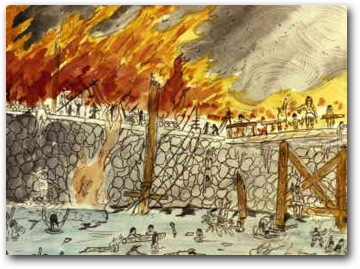 |
  People leaping into the river at Sumiyoshi Bridge, 1,450 meters from the hypocenter. People leaping into the river at Sumiyoshi Bridge, 1,450 meters from the hypocenter.
MICHIDA Yoshie
32 years old in August 1945
[06_39]
 |
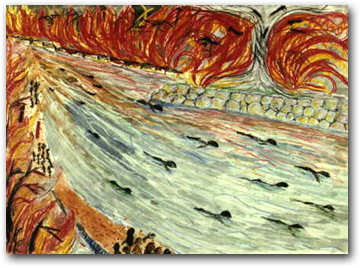 |
  “Corpses floating in the river.” “Corpses floating in the river.”
SASAKI Chizuko
20 years old in August 1945
[18_10]
 |
Corpses became bloated and discolored—literally monstrous. One survivor who painted such a scene 30 years later wrote of fearfully being led across a railroad bridge the day after the bomb was dropped, and seeing "red, blue, green, and purple corpses swollen three or four times floating under it."
|

 Crossing a streetcar bridge 1,680 meters from the hypocenter on August 7. The artist’s text tells of “red, blue, green, and purple corpses swollen three or four times” floating under the bridge.
Crossing a streetcar bridge 1,680 meters from the hypocenter on August 7. The artist’s text tells of “red, blue, green, and purple corpses swollen three or four times” floating under the bridge.
KIHARA Toshiko
17 years old in August 1945
[13_10] detail
 |
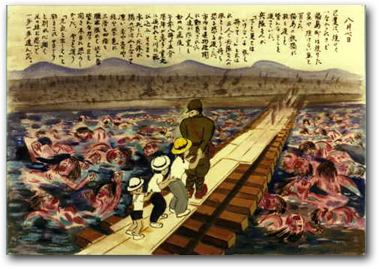 |
Water also became ghastly death in other ways. In Hiroshima, many people made their way to large cisterns that had been placed on the city streets for fighting fires. They drank from these because they were parched, and climbed into them in the hope, again, of escaping the firestorm. In one survivor's picture, a pregnant woman floats in the cistern and burned bodies hang over its edges. ("My chest hurts as I apply the red paint," the man who drew this in 1975 wrote.)
|
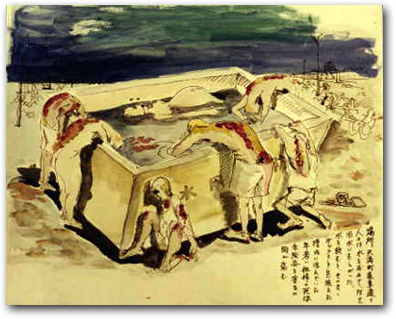 |

 Corpses at a cistern used for fire-fighting. “My chest hurts,” the artist notes in his text, “as I apply the red paint.” Corpses at a cistern used for fire-fighting. “My chest hurts,” the artist notes in his text, “as I apply the red paint.”
ONOGI Akira
15 years old in August 1945
[13_11]
 |
Another rendering depicts a cistern choked with red corpses locked in a grotesque rigor mortis of furious screaming.
|

 “Corpses in the fire cisterns were swollen red, while those in the vicinity were charred.”
“Corpses in the fire cisterns were swollen red, while those in the vicinity were charred.”
OGAWA Sagami
28 years old in August 1945
[15_44]
 |
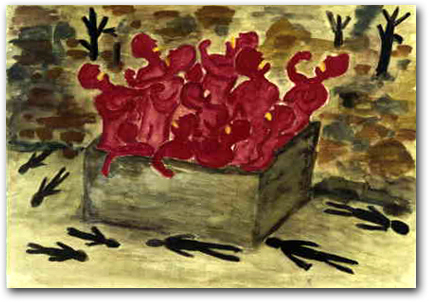 |
Water also became an abiding symbol of what we speak of clinically as the guilt of the survivor. Injured people experienced thirst, and many cried out for water in their final moments. Because they had been instructed by public authorities not to give food or liquids in such circumstances (since this might exacerbate internal injuries), many survivors did not respond to these last requests. They bore the burden ever after of failing to give comfort to a victim in his or her last moments.
|
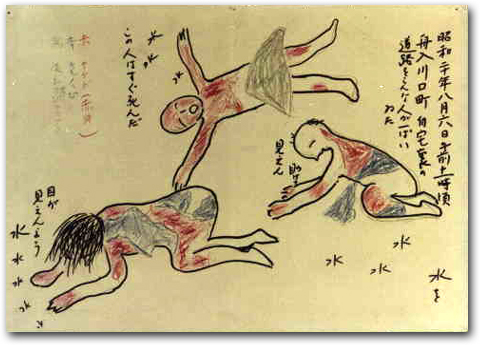 |
Victims beg for water and cry out that they can not see.
UESUGI Ayako
45 years old in August 1945
[15_02]
 |
An injured woman asks for water.
YAMASAKI Sayoko
23 years old in August 1945
[01_22]
 |
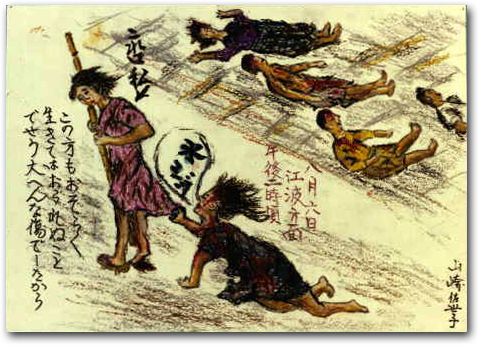 |
Guilt similarly consumed survivors who were unable to save a loved one, or even a stranger, pinned in collapsed buildings as the flames advanced. In one drawing, a survivor prays for forgiveness as a trapped stranger urges her to flee.
|
 YAMASHITA Masato
YAMASHITA Masato
20 years old in August 1945
[26_42]
 |
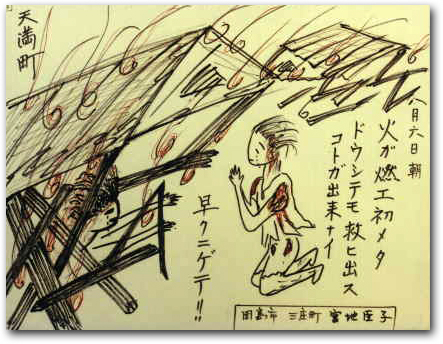 |
|
  1,300 meters from the hypocenter, the artist begs forgiveness for being unable to save a stranger trapped under a collapsed building. “The flames began to rise. There was nothing I could do to help. ‘Get away, hurry!’ the person screamed at me.” 1,300 meters from the hypocenter, the artist begs forgiveness for being unable to save a stranger trapped under a collapsed building. “The flames began to rise. There was nothing I could do to help. ‘Get away, hurry!’ the person screamed at me.”
|
Other survivors chose to tell of the "black rain" (kuroi ame) that fell on Hiroshima. Although the weather was clear when the bomb was dropped, the explosion changed the atmosphere and rain began to fall soon afterwards. This was welcomed.
|
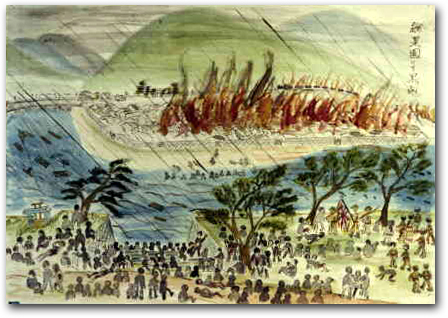 |
CHAKIHARA
Jitsuto
31 years old in
August 1945
[15_42]
 |
Black rain falls 1,300 meters from the hypocenter, as fire consumes
the city on the other side of the river.
|
|
Parched survivors even turned back their heads to catch raindrops in their mouths. Here, at least, was a tiny blessing.
|

 “A woman driven by unbearable thirst tried to catch the black raindrops in her mouth.”
“A woman driven by unbearable thirst tried to catch the black raindrops in her mouth.”
TAKAKURA Akiko
19 years old in August 1945
[13_06] |
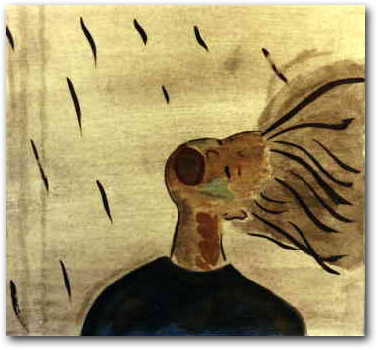 |

It was observed at the time, but without knowing what it meant, that the rain left black streaks on light clothing or walls. It was, in fact, bringing back radioactive debris. As a consequence, people who thought they had escaped death or serious harm often had not. Weeks or even months later, whether from direct and immediate exposure to the bomb's radiation or from exposure to the black rain, survivors began to show the symptoms of radiation sickness: nausea, diarrhea, bloody vomit, urine, and stools, hair loss, bruise-like spots all over the body. ("Black Rain" became the title of a celebrated book by Ibuse Masuji, and the book in turn became a well-known movie with the same title.)
|
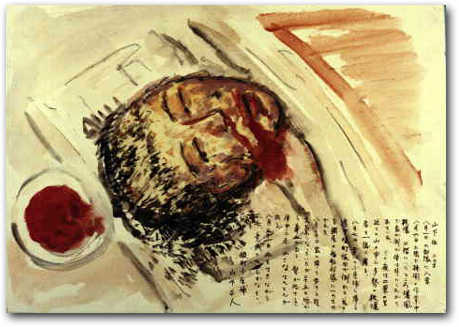 |
YAMASHITA
Masato
20 years old in
August 1945
[06_36]
 |
  The artist’s text tells how his younger brother was exposed to radiation while doing demolition work (to prevent fires) on August 6. “He returned home on August 20. On around the 25th, his nose began bleeding, his hair fell out, and small red spots appeared all over his body. On the 31st, he died while vomiting blood.” The artist’s text tells how his younger brother was exposed to radiation while doing demolition work (to prevent fires) on August 6. “He returned home on August 20. On around the 25th, his nose began bleeding, his hair fell out, and small red spots appeared all over his body. On the 31st, he died while vomiting blood.”
|
|
|
|

